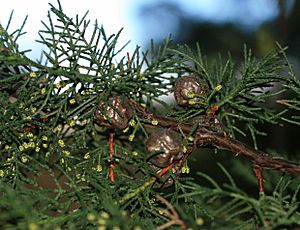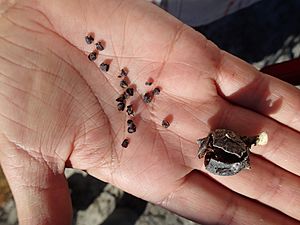Santa Cruz cypress facts for kids
{{Speciesbox | name = Santa Cruz cypress | image = N20161202-0002 — Cupressus abramsiana — RPBG (30675196384).jpg | image_caption = Santa Cruz Cypress in a tree nursery. | status = CR | status_system = IUCN3.1 | status_ref = | status2 = T | status2_system = ESA | status2_ref = | taxon = Cupressus abramsiana | authority = (C.B.Wolf) Bartel | range_map = Cupressus abramsiana range map 4.png | range_map_caption = Range map
| synonyms =
Cupressus goveniana var. abramsiana (C.B.Wolf) Little
Callitropsis abramsiana (C.B.Wolf) D.P.Little
Cupressus abramsiana subsp. butanoensis Silba
Cupressus abramsiana subsp. locatellii Silba
Cupressus abramsiana subsp. neolomondensis Silba
Cupressus abramsiana subsp. opleri Silba
Cupressus goveniana subsp. abramsiana (C.B.Wolf) A.E.Murray
Hesperocyparis abramsiana var. butanoensis (Silba) Bartel & R.P.Adams
Neocupressus goveniana var. abramsiana (C.B.Wolf) de Laub.
} The Santa Cruz cypress (Hesperocyparis abramsiana) is a special type of tree. It belongs to the cypress family. This tree is found only in the Santa Cruz Mountains of central California. You can find it in Santa Cruz and San Mateo counties.
In 1987, the U.S. Fish and Wildlife Service listed this tree as endangered. This was because its home was shrinking. Also, natural forest fires, which the tree needs, were not happening as they should. By 2016, its status improved to threatened. This change happened because the threats to its habitat had decreased.
Contents
What Does the Santa Cruz Cypress Look Like?
These trees can grow quite tall, from 10 to 25 meters (about 33 to 82 feet). Their branches are thick, about 5-10 cm (2-4 inches) wide. These branches grow almost all the way down to the ground. The tree has a pyramid shape, with longer branches near the bottom.
The leaves are light green and look like scales. They can be up to 15 mm (about half an inch) long. These leaves stay on the branches for many years. The bark on the trunk is stringy and has thin gray stripes.
Santa Cruz cypresses start making cones when they are about 11 years old. The pollen cones are small, up to 4 mm long. They release a lot of pollen that the wind carries. The female seed cones grow every year. They are about 20 to 30 mm (0.8 to 1.2 inches) wide. These seed cones stay on the tree until the branch they are on dies. This usually happens because of natural fires. These trees can live for over 100 years. Some have been found to be between 127 and 162 years old!
How the Santa Cruz Cypress Reproduces
Santa Cruz cypresses usually start reproducing around 11 years old. The seeds are less likely to grow into new trees once the parent tree is 30 years old.
Like some other cone-bearing trees, the Santa Cruz cypress needs fire to help its seeds grow. The heat from a fire makes the seed cones open up. This releases the seeds. The fire also burns other plants in the area, including the parent tree. This way, the cypress seeds can sprout and grow without other plants competing for space and sunlight.
Where the Santa Cruz Cypress Lives
The Santa Cruz cypress lives in chaparral and closed-cone pine forest areas. These are found in the Santa Cruz Mountains. They grow at elevations from 300 to 750 meters (about 980 to 2,460 feet). The soil there is often sandy or rocky and not very rich.
The weather in this area has cool, wet winters and hot, dry summers. Natural fires happen sometimes, clearing out the plants. The Santa Cruz cypress has learned to depend on these fires to reproduce. These trees are called obligate seeders. This means the parent tree dies in the fire. But its seeds sprout after the fire, growing in the newly cleared land.
If fires happen too often, young cypress trees don't get enough time to grow up and make their own seeds. If fires don't happen often enough, the trees can't reproduce enough to keep their numbers strong.
Where Can You Find These Trees?
This tree species grows in a small area of only 16 square kilometers (about 6.2 square miles) in California. Within this small area, there are five different spots where these trees grow. These spots are in the Santa Cruz Mountains and parts of Santa Cruz and San Mateo counties.
Long ago, these trees grew over a much larger area, about 76 square kilometers (30 square miles). Today, there are fewer than 300 Santa Cruz cypress trees in total. Some places only have a few trees left.
Protecting the Santa Cruz Cypress
The International Union for the Conservation of Nature (IUCN) first listed the Santa Cruz cypress as endangered in 1998. In 2011, they changed its status to critically endangered. This means it was at a very high risk of disappearing.
The U.S. Fish and Wildlife Service also listed the tree as endangered in 1987 under the United States' Endangered Species Act. After reviewing its status, they reclassified it as threatened in 2015. This means it's still at risk, but not as immediately as endangered.
What Threats Does the Santa Cruz Cypress Face?
Changes in Fire Patterns
Today, the Santa Cruz cypress habitat doesn't have fires as often as it naturally should. Without these fires, the trees don't grow or reproduce much. Older trees stop making good seeds. Also, fires started by people can happen too often. These fires can destroy young trees before they are old enough to reproduce. The U.S. Fish and Wildlife Service says that these changes in fire patterns are a big threat.
Nonnative Plants
Plants that are not native to the area can cause problems. They compete with the cypress trees for sunlight and space in the soil. For example, Acacia dealbata and Genista monspessulana are nonnative plants that harm Santa Cruz cypress populations. Since these trees grow close to neighborhoods, more nonnative plants could be brought in by people walking or doing other activities.
Other Dangers
Climate change is another big threat. Warmer temperatures might make the trees move to new areas. It could also change how often fires happen. People sometimes damage the trees by carving into their bark. This can lead to infections and diseases. In the past, turning the land into farms or homes was a major threat. But now, with protections in place, this threat has decreased.
What's Being Done to Help?
The U.S. Fish and Wildlife Service created a plan in 1998 to help the Santa Cruz cypress recover. An updated plan in 2009 suggested changing the tree's status to threatened. This would happen once all five groups of trees and their homes are protected. The main threats they want to control are logging, turning land into farms, and building new homes.
The plan says that all 356 acres of the cypress's home are important for saving the species. It also suggests taking the tree off the endangered list if all five groups of trees can reproduce successfully for a long time. They also have stored seeds in case something goes wrong.
Local rules and plans from Santa Cruz and San Mateo counties now protect some of these tree groups. More than half of all Santa Cruz cypress trees are on private land owned by people who care about conservation. State and county parks protect the rest of the trees. Plans to manage water in some of these areas have also started to help protect the trees.




